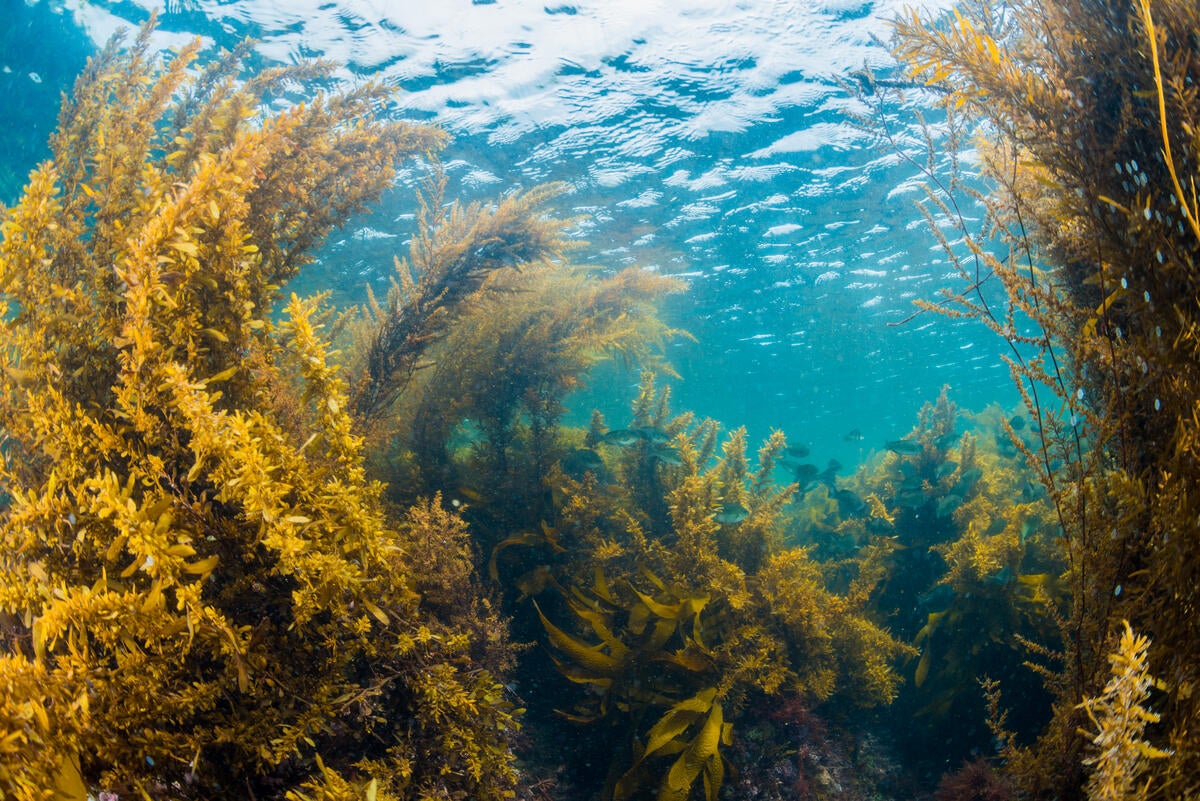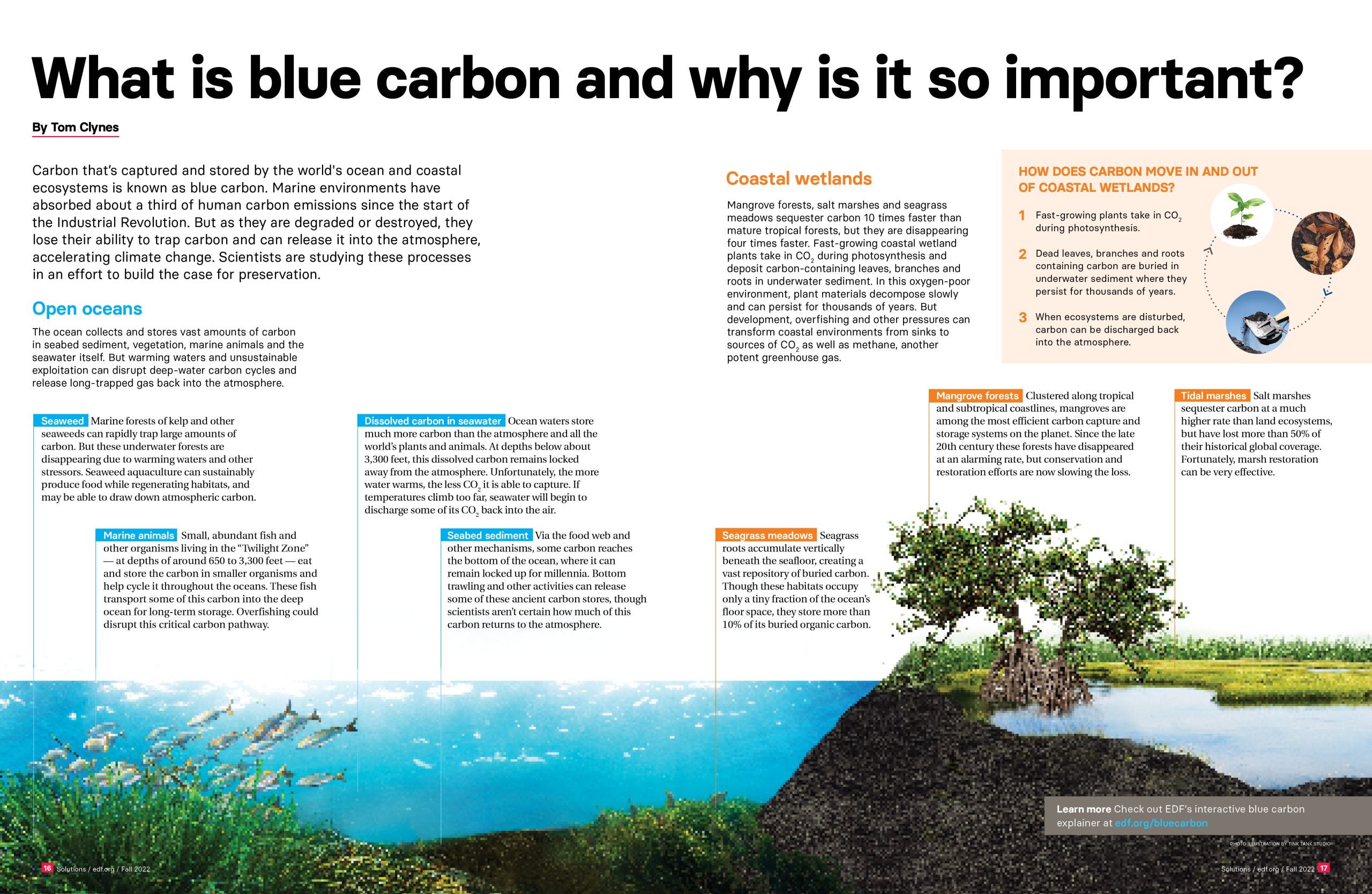Three new reports examine the potential of blue carbon pathways to act as natural climate solutions.
By Kristin Kleisner, Monica Moritsch and Jamie Collins
To address the climate crisis we need to explore every avenue possible, investigate innovative solutions, and even look to the oceans for answers. The oceans already serve the planet as a massive natural carbon sink, but because of climate change, overfishing and other pressures, we’ve degraded the natural pathways through which oceans trap carbon.
Blue Carbon is the carbon that is captured and stored in marine plants, animals, waters and sediments — and interventions to increase stocks of this blue carbon could form the basis for the next big natural climate solution (NCS).
With funding from the Bezos Earth Fund, the Environmental Defense Fund brought together over 60 researchers from the natural and social sciences and experts on marine economics, governance and policy for a series of workshops to investigate the magnitude of potential climate benefits, ecological interactions, and socioeconomic considerations for a variety of blue carbon natural climate solutions. The result: three new reports that identify the most promising pathways to preserve or increase stocks of blue carbon, generate co-benefits for people and nature, and secure a better future for us all. We are excited to present these reports that provide an overview of the state of the science on blue carbon, and identify challenges and opportunities for outcomes such as the inclusion of blue carbon into countries’ Nationally Determined Contributions (NDCs) and the possible integration of blue carbon into global carbon markets. Below, we break down the main takeaways from each report.
Promising possibilities for seaweed
The Carbon Sequestration by Seaweed report focuses on three interventions for increasing seaweed-based carbon sequestration:
- Conserving existing seaweed forests and restoring forests that have declined
- Increasing productivity and carbon sequestration performance of existing seaweed farms via capacity building
- Expanding seaweed farming into offshore waters.
With respect to the expansion of seaweed farms, the report found that there are key places around the world that offer suitable conditions for expanding seaweed cultivation. For example, in the U.S. Caribbean and Florida, almost 80% of the total area within 10-100m depth is potentially available for seaweed farming or has no conflicts with navigation, natural resources, oceanographic conditions. The report also notes that expansion of seaweed farming into offshore waters is perhaps the most promising way to increase C sequestration by seaweeds at a scale that could significantly contribute to climate stabilization.
The findings also emphasize the importance of the outcomes of seaweed. For example, methods of directly sinking seaweed into the deep ocean could provide an immediate and direct climate outcome in terms of carbon sequestration. However, sinking seaweed would preclude generation of other benefits and could entail several poorly understood ecological risks. Natural stands of seaweed and seaweed farms provide an important source of nutrition and could contribute to the reduction of GHG emissions if seaweed is used to make products that can replace GHG-intensive products like cement, plastics, and fertilizer. It may also prove possible to feed small amounts of certain seaweed species to ruminants to reduce their methane emissions. Expanding markets for seaweed products to produce climate benefits could ultimately result in regenerative solutions that benefit people and nature.
The ‘twilight zone’ warrants more attention
The Natural Climate Solutions in the Open Ocean report explores interventions based on reforming fishing practices to reduce fuel emissions and protecting fish and marine mammal species that are key to mediating the flow of carbon. The report takes a close look at one potential intervention based on a hypothetical and much-hyped pathway that has been termed the ocean “whale pump.” This phenomenon is hypothesized to occur when whales feed in the deep ocean and then defecate at the ocean surface, depositing nutrients that may stimulate algal blooms, which can, under the right conditions, capture and sequester carbon from the atmosphere. This sequestration is in addition to the more clearly defined amount carbon that animals like whales sequester when they die and sink to the ocean floor. As interesting and charismatic as this “whale pump” sounds — and while there are scores of critical reasons to preserve and rebuild whale populations —the expert group noted there may be limited potential in the restoration of whale populations as a natural climate solution due to poorly understood science, a risk of moral hazard and the fact that whales are already a protected species in many of the world’s oceans. However, the experts EDF convened identified more potential in a much less well-known pathway: the preservation of the ocean’s “twilight zone,” or mesopelagic, ecosystem. Millions of mysterious fishes and other creatures that live at depths of 200-1000m below the ocean surface migrate up and down in the water column every day, bringing carbon from the surface to the deep, where it can be locked away for millennia. Because the biomass of these species is vast, their role in the carbon pump is likely massive, even when calculations are based on the low end of their estimated populations. As demand for seafood from wild capture fisheries and the need for fishmeal for aquaculture increases, it is highly likely that this as-of-yet untapped resource will be targeted for industrial-scale fishing. Given the high stakes for our climate, we found that protection of the twilight zone’s critical blue carbon benefits constitutes an urgent imperative. EDF’s experts also found there were likely massive reductions in existing emissions to be realized in reducing fossil fuel consumption by global fishing fleets.
An uncertain future for nearshore ecosystems
The Coastal Natural Climate Solutions report revealed uncertainty around the ability of some coastal blue carbon ecosystems to sequester carbon, especially due to climate change impacts on fragile nearshore systems. This may call into question the ability of some nearshore systems to serve as NCS and to provide robust crediting opportunities within existing carbon markets. In addition, the group identified an urgent need to account for emissions from these ecosystems of greenhouse gases (GHGs) other than carbon dioxide, including methane and nitrous oxide. Regardless, preservation and restoration of mangroves and tidal marshes will incur massive benefits for livelihoods, coastal protection, and biodiversity — and these co-benefits can’t be overlooked.
Looking ahead
EDF and partners are continuing to explore blue carbon NCS and more quantitatively evaluate the climate and ecosystem benefits these systems could provide, as well as the socio-economic risks and costs. There is also an effort to understand the political and cultural feasibility of implementing various blue carbon NCS in different geographies and contexts. Overall, the work to date has illuminated promising pathways, including the expansion of seaweed markets for regenerative products that have a lower GHG footprint and the protection of twilight zone fishes. We hope that the consensus reached during the year-long series of blue carbon workshops will cut through the hype to help practitioners, standard-setting organizations and those focused on ocean solutions to identify pathways where science currently supports action, and where targeted research investments could spur emerging pathways to market readiness.
Read the reports:
- Natural Climate Solutions in the Open Ocean
- Coastal Natural Climate Solutions
- Carbon Sequestration by Seaweed
Visit our interactive site to learn more about blue carbon
Learn more about EDF’s work on blue carbon

